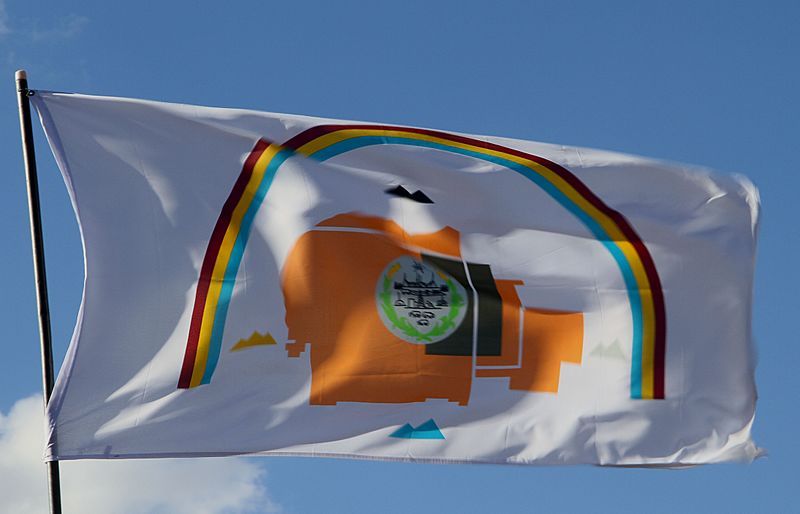Image: Navajo Nation flag (4910586306)

Description: The Navajo Nation flag, adopted on May 21, 1968 by the Navajo Tribal Council in Window Rock, Arizona, by Resolution CMY-55-68, was designed by Jay R. DeGroat, a Navajo student from Mariano Lake, Arizona. It was chosen from among 140 designs. The flag incorporates elements from the Navajo Nation Seal designed by John Claw, Jr. of Many Farms, Arizona and adopted on January 18, 1952. The Navajo Nation flag is a pale buff color (perhaps representing sand), bearing a map of the Navajo Nation in the center. The original area of the 1868 reservation is dark brown, while the much larger current borders are copper. Elements from the seal are added to the flag. Surrounding the map are the four sacred mountains: black above, turquoise below, white to the right, and yellow to the left. These colors form a recurring theme in the legends of the Navajo, beginning with the Navajo creation story. In it the world began as a black island floating in the mist. Above it were four clouds, black, white, blue (meaning turquoise), and yellow. The story describes the colored clouds as successive worlds and narrates the themes of birth, propagation, flood, escape, and continuing life. Arching over the mountains and map is the rainbow of red, yellow, and blue, with red outermost in reverse sequence from the Navajo Nation seal. The rainbow symbolizing Navajo sovereignty. Centered on the map is a white disk bearing the corn stalks and three domestic animals from the Navajo Nation seal representing the Navajo livestock economy, along with symbols of other aspects of the Navajo economy: a traditional hogan (hooghan), modern home, oil derrick, forestry, mining, which symbolizes the resource potential of the Navajo Nation, and recreational fishing and hunting. All but the green and yellow corn stalks appear in black outline. At the top near the sun, the modern sawmill symbolizes the progress and industry characteristic of the Navajo Nation's economic development. The overall image of the Navajo Nation flag recalls an art form closely associated with the Navajo sand painting. Many of the flag's details, and the sand-colored background, are frequently found in these temporary art works that initially served as sand altars that Navajos sit on in various healing ceremonies, although many traditional Navajos object to the sale of sand painting that have sacred symbols. The orientation of the sacred mountains on the flag differs from the seal. The Navajo consider east (hááaah) to be where everything begins and signifies all things good and beautiful, it is the location of the white mountain. On the Navajo Nation seal, east and the white mountain are at the top; on the Navajo Nation flag, they are to the right. In 1995, the Navajo Nation flag became the first Native American tribal flag in space when astronaut Bernard Harris carried it aboard the space shuttle Discovery. Dr. Harris is an African-American physician who lived on the Navajo Reservation as a child. He had asked the Navajo for a token to take into space with him and the Navajo Nation President chose the Navajo Nation flag. Navajo medicine men first blessed the flag by sprinkling corn pollen upon it, and were assured that the Discovery's flight conformed to Navajo religious belief and would fly in a clockwise direction. After its space flight, the Navajo Nation flag was proudly flown over the Navajo Nation Capitol in Window Rock, Arizona.
Title: Navajo Nation flag (4910586306)
Credit: Navajo Nation flag
Author: David from Washington, DC
Usage Terms: Creative Commons Attribution 2.0
License: CC BY 2.0
License Link: https://creativecommons.org/licenses/by/2.0
Attribution Required?: Yes
Image usage
The following page links to this image:

